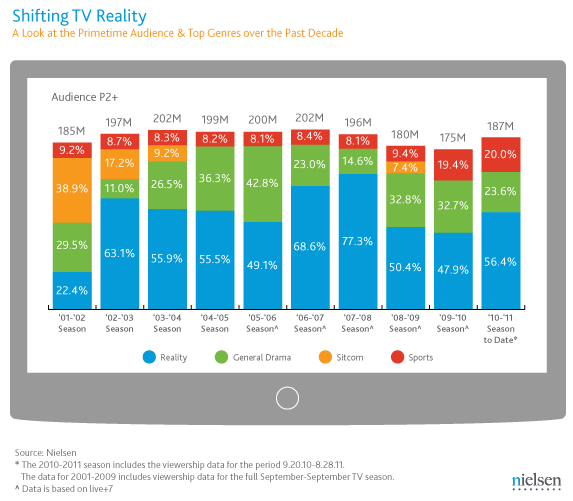Over the past 10 years, DVR, online streaming, digital cable, video on-demand and increased programming options have fundamentally changed the way Americans watch television. Yet, the audience size for broadcast primetime remains strong at just shy of 200 million viewers. What has changed, however, is the makeup of the programming in the popular 8-11 p.m. time block, according to Nielsen’s analysis of the top 10 primetime broadcast TV shows.
Reality Rises
Reality first made an appearance in the top 10 rankings in 2000, and since the 2002-2003 season has consistently captured the largest percentage of the audience watching the top 10 broadcast programs. In the 2007-2008 season, reality programming captured 77 percent of the total audience viewing those top 10 programs.
Sports Scores
The audience for Sports Events in the top 10 programs has hovered around 8 percent since the 2001 season, until it jumped to 19.4 percent in the 2009-2010 season and held tight last year.
Dramas Deliver
The audience for General Dramas peaked in the 2005-2006 season, accounting for 42.8 percent of the total audience, but decreased by about half last year, consisting of 21.6 percent of the total audience. Still, they have remained a consistent presence in the top 10.
Sitcoms Sit Out
Sitcoms, on the other hand, have had a tougher time holding a spot in the top 10. Once synonymous with primetime broadcasts, sitcoms disappeared from the ranking in the 2004-2005 season, only to return again briefly in the 2008-2009 season, making up just 7.4 percent of the total combined audience of the top ten programs.

Looking Ahead to this TV Season
Monday’s official kickoff of the Fall TV season creates opportunity for new TV hits and misses. Will sitcoms reclaim their position in the top ten ranking or will reality programs extend their reign? Or, will a new program type emerge and shake up the rankings yet again? Stay tuned.
Methodology
Nielsen analyzed the broadcast prime ranking reports for the September to September seasons over the past decade (September-STD for the 2010-2011 season) to determine the top genres of TV programs (type codes).
For each season, we selected the top ten broadcast primetime programs (ranked on HH rating) and added the average audience of each program together, to get one figure for the total combined audience of the top ten programs. Then, we added up the average audiences for each type code in the top ten list and calculated the percentage of the total audience for each type code. For example, in the 2001-2002 season, “General Drama” programming held 29.5% of the total audience for the top ten broadcast primetime programs.



